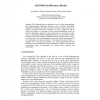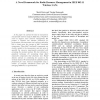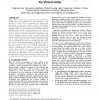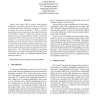EGC
2005
Springer
14 years 5 months ago
2005
Springer
Grid computing has been presented as a way to share geographically and organizationally distributed resources and to perform successfully distributed computation. For achieve this ...
ATAL
2005
Springer
14 years 5 months ago
2005
Springer
Scalable coordination is a key challenge in deployment of multiagent systems. Resource usage is one part of agent behavior which naturally lends itself to abstraction. CyberOrgs i...
WOWMOM
2005
ACM
14 years 5 months ago
2005
ACM
A dynamically extensible control plane is a key enabling feature of next generation intelligent selfconfiguring networks. This extensibility can be achieved by enabling service de...
WOSP
2005
ACM
14 years 5 months ago
2005
ACM
Resource pools are computing environments that offer virtualized access to shared resources. When used effectively they can align the use of capacity with business needs (flexi...
ANCS
2005
ACM
14 years 5 months ago
2005
ACM
Task to resource mapping problems are encountered during (i) hardware-software co-design and (ii) performance optimization of Network Processor systems. The goal of the first pro...
WIOPT
2005
IEEE
14 years 5 months ago
2005
IEEE
In this paper we address the need to characterize and quantify resource usage in IEEE 802.11 WLANs in order to support radio resource management. We present a compact and intuitiv...
LCN
2005
IEEE
14 years 5 months ago
2005
IEEE
— The problem of achieving fairness in the allocation of the bandwidth resource on a link shared by multiple flows of traffic has been extensively researched over the last deca...
CCGRID
2005
IEEE
14 years 5 months ago
2005
IEEE
We present an architectural framework for specifying and processing co-reservations in Grid environments. Compared to other approaches, our co-reservation framework is more genera...
CCGRID
2005
IEEE
14 years 5 months ago
2005
IEEE
Simple resource specification, resource selection, and effective binding are critical capabilities for Grid middleware. We the Virtual Grid, an abstraction for dynamic grid applic...
CCGRID
2005
IEEE
14 years 5 months ago
2005
IEEE
Internet data centers (IDCs) perform multi-customer hosting on a virtualized collection of resources while Grid computing generalizes distributed computing by focusing on large sc...




